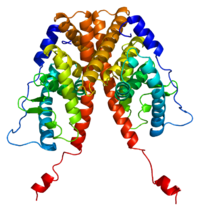Estrogen insensitivity syndrome
This article needs editing to comply with Wikipedia's Manual of Style. In particular, it has problems with not using MEDMOS. (July 2017) |
| Estrogen insensitivity syndrome | |
|---|---|
| Other names | EIS; Complete estrogen insensitivity syndrome; CEIS[1] |
 | |
| EIS results when the function of the estrogen receptor alpha (ERα) is impaired. The ERα protein (pictured) mediates most of the effects of estrogens in the human body. | |
| Specialty | Endocrinology |
Estrogen insensitivity syndrome (EIS), or estrogen resistance, is a form of
EIS is an extremely rare occurrence.[5][6] As of 2016, there have been three published reports of EIS, involving a total of five individuals.[6] The reports include a male case published in 1994,[7][8] a female case published in 2013,[5][9] and a familial case involving two sisters and a brother which was published in 2016.[6]
EIS is analogous to androgen insensitivity syndrome (AIS), a condition in which the androgen receptor (AR) is defective and insensitive to androgens, such as testosterone and dihydrotestosterone (DHT). The functional opposite of EIS is hyperestrogenism, for instance that seen in aromatase excess syndrome.
History
Male case
In 1994, a 28-year-old man was diagnosed with EIS after presenting to an
Treatment with up to very high doses of estradiol (fourteen 100-μg Estraderm patches per week) had no effect on any of his symptoms of hypoestrogenism, did not produce any estrogenic effects such as gynecomastia, and had no effect on any of his physiological parameters (e.g., hormone levels or bone parameters), suggesting a profile of complete estrogen insensitivity syndrome.[7]
Female case
In 2013, an 18-year-old woman with EIS was reported.
The patient had a small
Treatment of the patient with
Familial case
In 2016, a familial instance of EIS involving three siblings was reported.
All three siblings presented with
In all three siblings,
All three siblings were homozygous for a
As the sisters had very high, supraphysiological levels of circulating estradiol, the authors cautioned that it could not be ruled out that estradiol may have exerted some functional influence on their phenotypes via signaling through the
Further cases
Two more cases of EIS in sisters were reported in 2022.[15]
Research
EIS can be experimentally induced in animals via
The following sections are an extensive though partial/incomplete list of deficits observed in ERKO mice.[16]
αERKO mice
Females
- Estradiol and LH levels are dramatically elevated due to loss of negative feedback by estradiol on the HPG axis.[16] FSH levels, in contrast, are normal.[16] Testosterone levels are also substantially elevated.[16] Prolactin levels are decreased by 5-fold, which is due to a loss of its estradiol-induced secretion from the anterior pituitary.[16]
- The infertile.[16] The ovarian phenotype closely resembles that of polycystic ovary syndrome (PCOS) in humans.[16] It is caused by chronic exposure to abnormally high levels of LH.[16] By 18 months of age, there is a 30 to 40% incidence of ovarian tumors.[16]
- The mammary gland is normal until puberty, at which point there is a complete absence of pubertal development and the gland remains in a prepubertal state.[16]
- Due to the substantially elevated testosterone levels, there is sexual receptivity, measured as lordosis behavior.[16] There are significant deficits in parental behavior, including a tendency toward infanticide, and aggressive behavior is increased.[16]
Males
- LH and testosterone levels are both increased 2-fold due to loss of negative feedback by estradiol on the HPG axis.[16]
- The Leydig cell hyperplasia, which is due to the increased levels of LH and intratesticular testosterone.[16] Further, there is a greater incidence of cryptorchidism (undescended/retracted testes).[16]
- There is complete infertility, which is due both to testicular defects and to severely compromised normal sexual behavior (see below).
- There are no obvious abnormalities in the
- Aggressive behavior is dramatically reduced, whereas parental behavior, in terms of infanticide, is relatively normal.[16] There is little effect on sexual behavior in terms of mounting and sexual attraction to females.[16] However, there is an almost complete lack of intromission and ejaculation, in spite of the relatively normal mounting rate.[16] This contributes to infertility.[16]
βERKO mice
Females
- The uterus, vagina, and oviducts are normal.[16] The ovary is normal prior to puberty, and there is still no gross aberrant phenotype during adulthood.[16] However, there is partial anovulation and subfertility, which is due to ovarian defects, namely compromised follicular maturation via loss of estradiol signaling in ovarian granulosa cells.[16]
- The mammary gland appears to be normal.[16]
- Body weight and fat distribution appear to be normal.[16]
- Increased forced swim test are lost.[17]
Males
- Fertility is full and normal, with a lack of relevant phenotypes observed.[16]
- The male accessory glands, including the prostate gland, bulbourethral glands, coagulating gland, and seminal vesicles, all seem to be normal.prostate hyperplasia with age.[18]
- Body weight and fat distribution appear to be normal.[16]
- There is a lack of grossly apparent behavioral phenotypes, including in regards to sexual behavior.[16] However, increased aggressive behavior is observed.[17]
GPERKO mice
GPER knockout mice have also been generated, and exhibit
Androgen insensitivity syndrome
In contrast to EIS,
References
- PMID 23499866.
- S2CID 24955164.
- PMID 8090165.
- S2CID 23063975.
- ^ ISBN 978-0-323-32195-2.
- ^ PMID 27754803.
- ^ PMID 8090165.
- ^ PMID 8701078.
- ^ PMID 23841731.
- ISBN 978-0-08-058132-3.
- ISBN 978-1-60913-345-0.
- ISBN 978-0-7295-8561-3.
- ISBN 978-1-4614-6633-8.
- ^ PMID 37873849.
- S2CID 246679004.
- ^ PMID 10368776.
- ^ S2CID 24199571.
- PMID 15709960.
- PMID 26189910.
- S2CID 10327090.
Further reading
- Bulun SE (2014). "Aromatase and estrogen receptor α deficiency". Fertil. Steril. 101 (2): 323–9. PMID 24485503.
